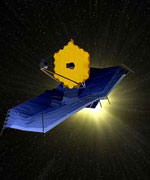
Image credit: NASA
NASA announced today that it has selected a beryllium-based mirror technology for the 6.5 mirror on the James Webb Space Telescope – the successor to the Hubble Space Telescope. The primary mirror will actually be made up of 18 hexagonal-shaped segments, giving it 2.5 times more surface area than Hubble’s mirror; but it will be one-third the weight. Construction of the mirror will begin next year, and the telescope is expected to launch some time after 2011.
NASA today announced a major milestone in the development of the James Webb Space Telescope (JWST), the selection of a beryllium-based mirror technology for the telescope’s 6.5-meter primary mirror.
The JWST prime contractor, Northrop Grumman, Redondo Beach, Calif., recommended that NASA select the mirror technology, supplied by Ball Aerospace & Technologies Corporation, Boulder, Colo., for the JWST primary mirror.
Northrop Grumman made the recommendation following a detailed process that took advantage of insights from a panel of experts representing the contractor team, NASA and the science community. Two mirror technologies, beryllium and ultra low-expansion glass, were tested, and their implementation plans were thoroughly reviewed during a six-month evaluation. Technical performance, manufacturing schedule, facilities, staffing, and cost were factors taken into consideration.
The production of the beryllium-based mirrors will begin within the next year. The mirrors will be incorporated into optical assemblies, mounted on the telescope structure, and subjected to a series of tests at cryogenic temperatures, individually and as an integrated system.
The Observatory design features a 6.5-meter aperture primary mirror, comprised of 18 hexagonal shaped segments. The telescope will be 2.5 times the diameter, yet weigh only one-third as much, as the mirror on the Hubble Space Telescope. JWST will be orders of magnitude more sensitive than ground-based infrared telescopes.
After launch in 2011, JWST will peer into the infrared at great distances to see the first stars and galaxies formed in the universe billions of years ago. A flagship mission in NASA’s Origins Program, JWST will search for answers to astronomers’ fundamental questions about the birth and evolution of galaxies, the size and shape of the universe, and the mysterious life cycle of matter.
NASA’s Goddard Space Flight Center, Greenbelt, Md., manages the JWST project for NASA Headquarters’ Office of Space Science, Washington. The project consists of an international team involving NASA, the European Space Agency, Canadian Space Agency, industry and academia.
Northrop Grumman is prime contractor leading a team including Ball Aerospace, Eastman Kodak Company, Rochester, N.Y.; and Alliant Techsystems, Magna, Utah. The major beryllium mirror subcontractors to Ball Aerospace are Tinsley Laboratories, Richmond, Calif.; Axsys Technologies, Cullman, Ala.; and Brush Wellman Inc., Elmore, Ohio.
Original Source: NASA News Release
